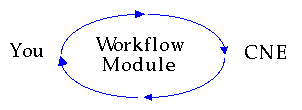
The CSCW research area is over a decade old and has already produced a wealth of technologies to support group and organizational work practices. Most of the research in CSCW is aimed at developing passive services, such as media spaces (computer-controllable networks of audio and video equipment used to support synchronous collaboration) , telephone-based interfaces to CSCW applications , and virtual workspaces (for examples of these systems see the ACM CSCW Conference proceedings in 1992). These passive services focus on information objects. Protocols are designed for synchronizing these objects under certain stylized patterns of use; the synchronization is mechanical and rule-based. None of these approaches places its services into a larger, active framework of coordination.
One of the first CSCW systems, the Coordinator (Flores et al 1988), was developed by Action Technologies using the model of language/action given in Winograd and Flores (1987). This model of coordination is based on speech acts (Austin, 1962) and commitments (Searle, 1979). The Coordinator was a first step in exploring how to develop an electronic messaging system to support coordination processes in organizations at the individual level. A remarkable side result of this pioneering system was the MHS electronic mail protocol, which is a widely used standard in current computer networks and is part of the Novell Netware.
A growing CSCW research direction is concerned with developing active theories of coordination to facilitate interactions between humans, using language action theory to model cooperative work. These include XCP (Sluzier & Cashman, 1984), CHAOS (De Cindio, De Michelis & C. Simone, 1986 ), COSMOS (Bowers & Churcher, 1988), and ConversationBuilder (Kaplan et. al., 1992). These systems, like the Coordinator, focus on tools for facilitating linguistic actions among humans (however, the Coordinator was explicitly developed for intentional speech acts). The number and diversity of these systems demonstrates the versatility of the theoretical framework. For more on CSCW in Europe, you may wish to visit the COMIC Project (Computer-based Mechanisms of Interaction in Cooperative Work).
Closely related to CSCW and Workflow is the research being done on Intelligent Agents and Cooperative Distributed Problem Solving (CDPS). There is a growing recognition that CSCW systems will need to work together (Bannon & Schmidt, 1991), where both formal and informal, individual and cooperative activies are supported by a set of common support services. A topic of future research is aimed at taking the technological and information services that CSCW, Intelligent Agents and CPDS provide and showing how they can be integrated into workflow loops which specify their interaction. The ultimate aim of this integration is to enable people to perform more effective actions.

MRH
8/31/94